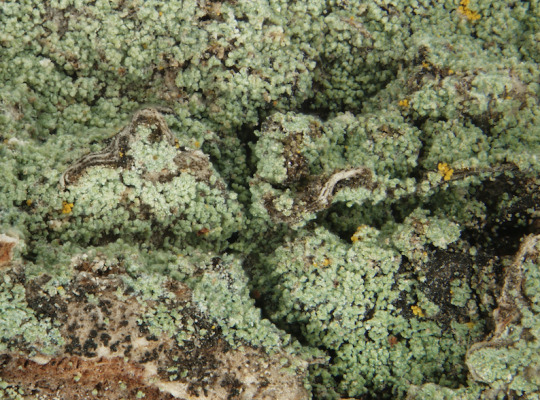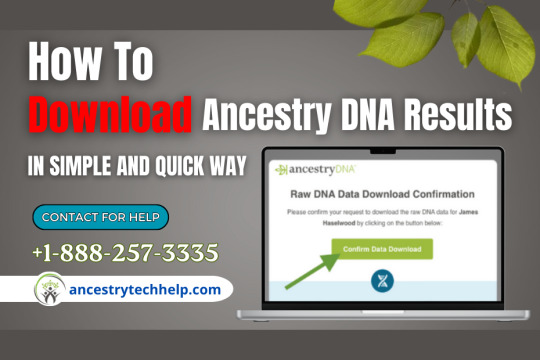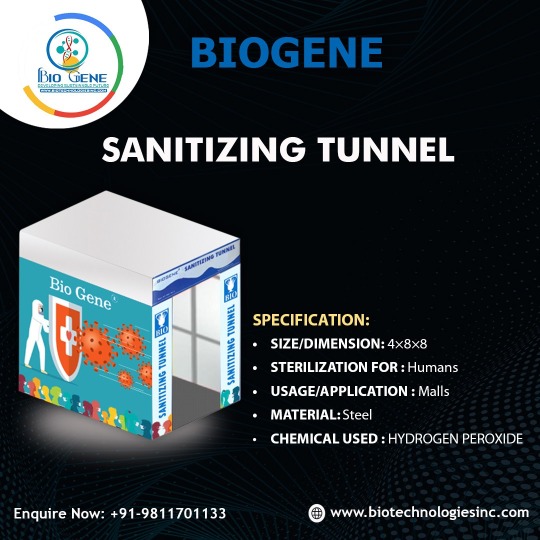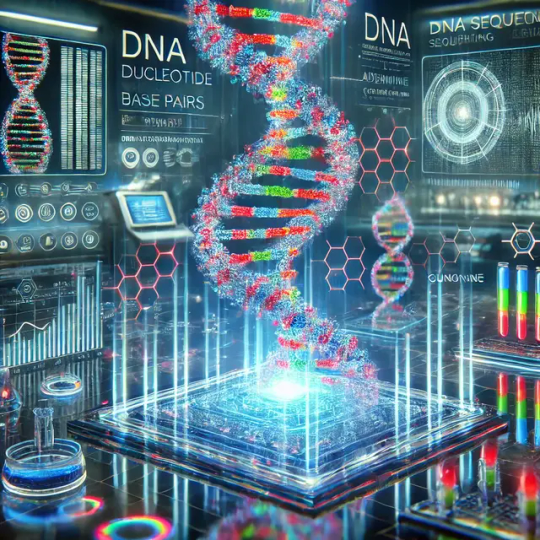#DNAanalysis
Explore tagged Tumblr posts
Text
An Unexpected Lichen, in Name and in Fact
ESP version ITA version

You are walking along trails you’ve hiked dozens of times when suddenly, you start wondering about the greenish-gray crusts on trees you often pass by. Equipped with paper bags, always handy in a professional lichenologist’s backpack, you begin sampling carefully. You send the samples to a colleague for a more precise identification and—surprise, surprise—four of them turn out to be completely different from the others.
At first, you classify these samples under the genus Lepraria due to some similarities, such as the very fine thallus that crumbles into granules. However, something feels off. You soon realize that these four specimens are not as green as you initially thought. Their crust has a bluish tint, with shades between turquoise and dark aqua-green—something neither of you had ever seen in any other lichen before. Not only that, but molecular analyses on the extracted DNA sequences place the specimens in another genus, Leprocaulon to be precise, without matching any previously sequenced species.
The plot thickens, and your research group expands. You decide to involve other experts to sequence the DNA from a larger sample size beyond the initial four specimens. More samples are collected, and now you are anxiously awaiting the results, as if you were waiting for the outcome of a paternity test.
And finally, what you had hoped for—but were hesitant to say out loud—becomes reality: you have just discovered a new species of lichen for Italy! But there’s more: the symbiotic alga—since lichens are living beings mainly composed of a symbiosis between a cyanobacterium (or an alga) and a fungus—also turns out to be new to science and belongs to the genus Symbiochloris!
Now comes the challenge of choosing a name. Since the first specimens were collected in the Ticino Valley, the research team initially leaned toward Leprocaulon ticinense. However, you—the lichenologist who first collected them—decide to take another walk, this time in Val Camonica. And what do you find on a chestnut tree? That same bluish lichen, in a completely different habitat. The initial name is thus discarded, and given the constant surprises this tiny living organism has provided and continues to provide, there is only one possible choice: Leprocaulon inexpectatum.
This discovery proves that, despite environmental degradation, there are still islands of biodiversity that persist and hold surprises. And who knows? Maybe the next new species is just waiting to be found by you, on one of your usual trails!
See You Soon, and Good Science!
Source
#DropsOfScience#nature#news#naturalSciences#lichens#ItalianDiscoveries#newSpecies#biodiversity#environment#unexpectedNature#lichenology#scienceNews#discoveries#wildlife#DNAanalysis#research#botany#ecology#exploration#molecularbiology
3 notes
·
View notes
Text
Unlocking Human Potential Through Genomic Sequencing
Genomic sequencing is rapidly transforming the landscape of modern medicine. By analyzing the DNA of individuals, scientists and doctors can unlock critical insights into genetic disorders, disease risks, and personalized treatment options. This powerful tool is redefining how we approach prevention, diagnosis, and therapy.
Key Benefits of Genomic Sequencing:
Personalized Medicine: Tailors treatments to an individual’s genetic profile, increasing effectiveness and minimizing side effects.
Early Disease Detection: Identifies genetic mutations associated with diseases before symptoms appear.
Ancestry and Trait Analysis: Offers insights into heritage and inherited traits.
Cancer Research: Helps in identifying mutations that drive cancer and suggests targeted therapies.
Rare Disease Diagnosis: Enables accurate identification of rare genetic disorders that traditional diagnostics may miss.
The Growing Impact:
As genomic sequencing becomes more accessible and affordable, its role in routine healthcare is expanding. From newborn screening to cancer treatment and pharmacogenomics, the potential applications are vast and still growing.
Genomic sequencing is not just a tool of the future—it’s a vital part of today’s healthcare revolution. Its ability to personalize and improve patient outcomes makes it one of the most promising advances in medicine.
#GenomicSequencing #PersonalizedMedicine #Genetics #FutureOfHealthcare #DNAAnalysis
0 notes
Text
0 notes
Text

Download ancestry DNA results
Learn to download Ancestry DNA results easily. Access the test management section, request a download, and confirm via email. Save the DNA data file within a week. Troubleshoot errors by clearing cookies or ensuring enough storage. For issues, contact support or use live chat for assistance.
https://ancestrytechhelp.com/download-ancestry-dna/
#AncestryDNA#DNAResults#DownloadAncestryDNA#FamilyTree#GeneticRelatives#EthnicityEstimate#AncestrySupport#AncestryHelp#DNADownloadGuide#AncestryTips#GeneticGenealogy#AncestryKit#DNAAnalysis#AncestryResearch#RawDNAData#GenealogyTools#AncestryLogin#FamilyHistory#AncestryResources
0 notes
Text
Next-Gen Accuracy: How DNA Analysis Techniques Are Evolving
Fueling the booming DNA Forensics Market, advancements in Next-Generation Sequencing (NGS), Capillary Electrophoresis (CE), and PCR Amplification are revolutionizing how we analyze evidence. Explore the accuracy limitations, cost-effectiveness
DNA Forensics Techniques The DNA Forensics Market is booming, fueled by advancements in various techniques. Let’s explore some key questions surrounding Next-generation Sequencing (NGS), Capillary Electrophoresis (CE), and PCR Amplification: 1. Accuracy and Limitations: NGS vs. Capillary Electrophoresis for DNA Analysis? Both NGS and CE are powerful tools, but they have distinct strengths and…

View On WordPress
#CapillaryElectrophoresis#DigitalForensics#DNAAnalysis#ForensicScience#ForensicTechnology#NextGenSequencing#NGS#PCR#TrueCrime
1 note
·
View note
Text
Dive into the intricate world of forensic science with our comprehensive MSc program. Explore crime scene investigation, DNA analysis, and more to embark on a career at the forefront of justice. Discover course details here!
#ForensicScience#MSc#CrimeSceneInvestigation#DNAAnalysis#ForensicPathology#CriminalJustice#ScienceEducation
0 notes
Text
Forensic Genomics Diagnostics: A Strategic Market Assessment
The global forensic genomics market size is expected to reach USD 1.36 billion by 2030, registering a CAGR of 14.25% in the forecast period, according to a new report by Grand View Research, Inc. This is owing to a significant increase in violent crimes, globally. Murder, intentional homicide, robbery, etc. are the key factors driving the growth of the industry. The Federal Bureau of Investigation predicted that there will be 1.31 million violent crimes in 2021. Homicides accounted for approximately 40.00% since before the pandemic, according to the FBI’s estimated homicide data. Forensic DNA profiling allows the identification of individuals of those who are already known to the investigating authorities.
Forensic Genomics Market Report Highlights
The growth of the overall market is attributed to the increasing crime rates along with the introduction of advanced technology for forensic testing
Key players are focusing on several strategic alliances, which, in turn, is driving the global industry
For instance, in August 2022, Thermo Fisher Scientific entered into collaboration with National Forensic Sciences University (NFSU) to establish the center of excellence for DNA forensics in India
The facility is equipped with advanced technologies, which would help researchers make evidence-based decisions
In August 2022, Verogen, Inc. formed a partnership agreement with Gene by Gene to accelerate Forensic Investigative Genetic Genealogy (FIGG) Adoption
The partnership would provide affordable whole genome sequencing services for complex samples and standardize bioinformatic techniques for FIGG analysis
Gain deeper insights on the market and receive your free copy with TOC now @: Forensic Genomics Market Report
New genetic markers have been produced as a result of recent research and they have the potential to address some significant shortcomings in DNA profiling techniques. In addition, several developments allow new kinds of relevant information to be obtained from biological samples. These include new molecular techniques for locating individuals that investigators were previously unaware of, and novel molecular approaches to support connections between criminal acts and sample donors. Such advancements in genomics, genetics and molecular biology are expected to enhance human forensic casework in the coming years. Advancements in technology have helped scientists create DNA fingerprints with smaller samples of DNA, therefore a suspect can be identified from a small amount of blood sample.
Next-generation Sequencing (NGS) offers results quickly and at a lower cost than other conventional techniques. Accordingly, to improve DNA testing accuracy, the number of regions used in STR analysis increased from 13 to 20 in 2017. In February 2022, researchers from the University of Washington along with the U.S. Department of Homeland Security used DNA testing of ivory shipments confiscated by law enforcement to identify the global criminal groups involved in ivory smuggling out of Africa. The kits & consumables product segment captured the highest revenue share in 2021 due to the high public & private investments in the development of DNA forensics.
The consumables include centrifuge tubes, cotton swabs, and filter baskets among others. The capillary electrophoresis method segment dominated the industry in 2021. Capillary electrophoresis is a fully automated technique used for detecting and separating Short Tandem Repeat (STR) alleles in genomic laboratories. Criminal testing was the largest application segment in 2021 owing to the increasing use of molecular testing technology for criminal investigation. North America dominated the global industry in 2021 due to various technological developments in the forensic sciences and growing investigation consent for forensic processes, such as biometric analysis methods and DNA profiling.
#ForensicGenomics#DNAAnalysis#GeneticEvidence#ForensicScience#CriminalJustice#GenomicForensics#ForensicTechnology
0 notes
Text



Efficiently control contamination: Pass Box, PCR Work Station, and Sanitizing Tunnel, your laboratory's guardians of purity.
Visit Here for More:- https://bit.ly/3O5HggL
#PassBox#SafeTransfer#SecurePassage#ContaminationControl#PCRWorkStation#LabSafety#DNAAnalysis#ResearchTools#SanitizingTunnel#HygieneStation#DisinfectionGateway#GermFreePassage#CleanAndSafe
0 notes
Text
DNA is digital now?? The digital genome market’s blowing up to $38.2B 🧬💻
Digital Genome Market is set to surge from $12.5 billion in 2024 to $38.2 billion by 2034, growing at a CAGR of 11.8%. This market covers a wide range of technologies and services, including genome sequencing, bioinformatics, and digital data storage, all aimed at transforming genetic information into actionable insights. These tools play a vital role in precision medicine, drug discovery, and disease prevention, revolutionizing the future of healthcare. The sequencing and analysis tools segment dominates, driven by growing demand in clinical diagnostics and therapeutic development. Bioinformatics is the next major segment, fueled by the need to interpret vast genomic datasets. North America leads the market, backed by cutting-edge R&D and healthcare innovation. Europe follows, with Germany emerging as a key contributor thanks to its emphasis on personalized medicine.
To Request Sample Report : https://www.globalinsightservices.com/request-sample/?id=GIS10511 &utm_source=SnehaPatil&utm_medium=Article
The U.S. holds the largest market share, owing to strong infrastructure, research funding, and industry collaboration. With projections to reach 550 million units by 2028, the market is being reshaped by advances in next-gen sequencing and increased focus on data analytics and storage.
#digitalgenome #genomemarket #precisionmedicine #genomics #bioinformatics #nextgensequencing #personalizedhealthcare #geneticanalysis #sequencingtools #genomicdata #healthtech #drugdiscovery #clinicaldiagnostics #datainterpretation #dataanalytics #biotechinnovation #biotechnology #digitalhealth #genomicanalysis #microarray #dnaanalysis #rnasequencing #methylation #genomesequencing #sangersquencing #genomicresearch #healthcareai #healthcaredigital #pharmatech #genomicinsights #forensicscience #genomicstorage #dataintelligence #biomedicalresearch #lifesciences
Research Scope:
· Estimates and forecast the overall market size for the total market, across type, application, and region
· Detailed information and key takeaways on qualitative and quantitative trends, dynamics, business framework, competitive landscape, and company profiling
· Identify factors influencing market growth and challenges, opportunities, drivers, and restraints
· Identify factors that could limit company participation in identified international markets to help properly calibrate market share expectations and growth rates
· Trace and evaluate key development strategies like acquisitions, product launches, mergers, collaborations, business expansions, agreements, partnerships, and R&D activities
About Us:
Global Insight Services (GIS) is a leading multi-industry market research firm headquartered in Delaware, US. We are committed to providing our clients with highest quality data, analysis, and tools to meet all their market research needs. With GIS, you can be assured of the quality of the deliverables, robust & transparent research methodology, and superior service.
Contact Us:
Global Insight Services LLC 16192, Coastal Highway, Lewes DE 19958 E-mail: [email protected] Phone: +1–833–761–1700 Website: https://www.globalinsightservices.com/
0 notes
Text

DNA Sequencing
DNA sequencing is the process of determining the precise order of nucleotides (adenine, thymine, cytosine, and guanine) in a DNA molecule. It plays a critical role in understanding the genetic makeup of organisms and has wide-ranging applications in genetics, medicine, biotechnology, and forensic science.
Types of DNA Sequencing Techniques:
Sanger Sequencing:
Developed by Frederick Sanger in the 1970s, it uses chain termination methods to determine DNA sequences.
Despite being slower than newer methods, it is still widely used for smaller DNA fragments due to its high accuracy.
Next-Generation Sequencing (NGS):
A high-throughput method that can sequence millions of DNA fragments simultaneously.
Faster, cheaper, and more efficient than Sanger sequencing, making it suitable for large-scale projects like whole-genome sequencing.
Third-Generation Sequencing (TGS):
Includes techniques like Single-Molecule Real-Time (SMRT) sequencing and nanopore sequencing.
TGS allows for longer read lengths, providing better insights into structural variations and complex regions of the genome.
Applications of DNA Sequencing:
Genomics: Whole-genome sequencing to study genetic variation and hereditary traits.
Medicine: Precision medicine, where DNA sequencing is used to personalize treatment plans based on a patient's genetic makeup.
Cancer Research: Identifying mutations that drive cancer and developing targeted therapies.
Forensics: DNA fingerprinting to solve crimes or establish familial relationships.
Agricultural Biotechnology: Improving crop varieties and livestock through genetic insights.
Challenges and Future Directions:
While DNA sequencing has become more accessible due to decreasing costs, challenges remain in analyzing and interpreting large volumes of genomic data. Advances in bioinformatics, AI, and machine learning are helping to overcome these obstacles. The future of DNA sequencing holds potential for faster, more accurate, and cost-effective sequencing with applications in areas such as synthetic biology, population genetics, and personalized healthcare.
Biotechnology Scientist Awards
Visit Our Website : http://biotechnologyscientist.com
Contact Us : [email protected]
Nomination Link : https://biotechnologyscientist.com/award-nomination/?ecategory=Awards&rcategory=Awardee
#sciencefather#researchawards#Scientist#Scholar#Researcher#DNASequencing #Genomics #GenomeResearch #GeneticTesting #NextGenSequencing #NGS #PrecisionMedicine #GeneticEngineering #DNAAnalysis #MolecularBiology #SangerSequencing #Bioinformatics #GeneEditing #CRISPR #WholeGenomeSequencing #CancerGenomics #PersonalizedMedicine #DNAFingerprinting #BiomedicalResearch #GeneticData #ThirdGenSequencing #Biotechnology #SyntheticBiology #MedicalGenomics #HumanGenome
👉Don’t forget to like, share, and subscribe for more exciting content!
Get Connected Here: =============
Facebook : https://www.facebooFk.com/profile.php?id=61572562140976
Twitter : https://x.com/DiyaLyra34020
Tumblr : https://www.tumblr.com/blog/biotechscientist
Blogger: https://www.blogger.com/u/1/blog/posts/3420909576767698629
Linked in : https://www.linkedin.com/in/biotechnology-scientist-117866349/
Pinterest : https://in.pinterest.com/biotechnologyscientist/
0 notes
Text
🌿 Unlocking the Secrets of Personalized Nutrition 🌟
Ever wondered why your body reacts differently to certain foods compared to others? Enter nutrigenomics—a cutting-edge fusion of genetics and nutrition that’s changing how we approach health and wellness! 🧬🥗
Download Sample: click
Here's the scoop: ✨ Genetic testing (yes, through saliva or blood!) uncovers how your body processes nutrients. ✨ Tailored dietary recommendations help you eat according to your unique genetic profile. ✨ It’s the ultimate personalized approach to preventive healthcare!
💡 The global nutrigenomics market is booming, expected to grow from $600M in 2023 to $1169M by 2030. With advancements in technology and a growing focus on wellness, the future is looking bright for this innovative field.
Inquire to Buy: click
Let’s embrace a world where our diets are as unique as our DNA! 🌟


#Nutrigenomics #PersonalizedNutrition #DNAAnalysis #WellnessJourney #HealthInnovation #FutureOfHealth
0 notes
Video
youtube
"QCM-DNA Biosensor for SNP Detection: Wine Authenticity Case" #sciencefather #Biosensor #scientists
We introduce a QCM-DNA biosensor designed for precise single nucleotide polymorphism (SNP) detection, tailored to varying sample complexities. This optimized protocol leverages thiolated probe reduction with TCEP and immobilization in MgCl2-enriched PBS for enhanced hybridization efficiency. Operated at 37°C, the biosensor achieves high specificity, identifying single mismatches using synthetic and real DNA samples.
website: https://popularscientist.com/
#Biosensor #SNPDetection #WineAuthenticity #QCM #DNAAnalysis #FoodAuthentication #Sustainability #LabInnovation
0 notes
Text
Future-Proofing Medicine with Genomic Sequencing
Genomic sequencing is rapidly transforming the landscape of modern medicine. By analyzing the DNA of individuals, scientists and doctors can unlock critical insights into genetic disorders, disease risks, and personalized treatment options. This powerful tool is redefining how we approach prevention, diagnosis, and therapy.
Key Benefits of Genomic Sequencing:
Personalized Medicine: Tailors treatments to an individual’s genetic profile, increasing effectiveness and minimizing side effects.
Early Disease Detection: Identifies genetic mutations associated with diseases before symptoms appear.
Ancestry and Trait Analysis: Offers insights into heritage and inherited traits.
Cancer Research: Helps in identifying mutations that drive cancer and suggests targeted therapies.
Rare Disease Diagnosis: Enables accurate identification of rare genetic disorders that traditional diagnostics may miss.
The Growing Impact:
As genomic sequencing becomes more accessible and affordable, its role in routine healthcare is expanding. From newborn screening to cancer treatment and pharmacogenomics, the potential applications are vast and still growing.
Genomic sequencing is not just a tool of the future—it’s a vital part of today’s healthcare revolution. Its ability to personalize and improve patient outcomes makes it one of the most promising advances in medicine.
#GenomicSequencing #PersonalizedMedicine #Genetics #FutureOfHealthcare #DNAAnalysis
0 notes
Text
Mae Hong Son Caves: 20-Year Archaeological Project Yields DNA Insights
In Pang Mapha, Mae Hong Son, a 20-year archaeological project led by Rasamee Chusongdet reveals ancient human DNA, offering insights into early populations and their environment. #southeastasianarchaeology #Thailand #archaeology #DNAanalysis
via 101 World, 03 June 2024: In Mae Hong Son’s Pang Mapha District, archaeologist Prof. Dr. Rasmi Shoocongdej leads a 20-year project uncovering ancient human remains in cliff caves. DNA analysis from these remains reveals insights into the early human population and their environment. The project emphasizes collaboration with local communities and interdisciplinary methods, highlighting the…

View On WordPress
0 notes
Text
The Role of DNA Analysis in Modern Human Identification
Human identification technologies are transforming the fields of security, forensics, and healthcare by providing accurate and efficient methods to verify and authenticate individuals. These technologies include biometrics such as fingerprint recognition, facial recognition, iris scanning, and DNA analysis, which offer high precision and reliability. Advances in artificial intelligence and machine learning have further enhanced these systems, enabling real-time identification and reducing the risk of fraud. In healthcare, human identification ensures the correct matching of patients to their medical records, thereby improving patient safety and care continuity. As privacy concerns and ethical considerations are addressed, human identification technologies continue to evolve, offering robust solutions for various applications.
#HumanIdentification #Biometrics #AIinTech #FacialRecognition #FingerprintTech #IrisScanning #DNAAnalysis #SecurityTech #HealthcareInnovation #PatientSafety #MachineLearning #TechAdvancements #Forensics #PrivacyTech #EthicalAI
0 notes
Text
Empowering Expectant Parents: The Evolution of Non-Invasive Prenatal Testing (NIPT)
Non-Invasive Prenatal Testing (NIPT) has revolutionized prenatal care by offering a safe and accurate method to screen for genetic conditions in unborn babies.
This innovative testing analyzes cell-free fetal DNA circulating in the mother's blood to detect chromosomal abnormalities like Down syndrome with high sensitivity. NIPT is a non-invasive alternative to procedures like amniocentesis, reducing risks to both the mother and fetus. Expectant parents benefit from early and reliable information about their baby's health, enabling them to make informed decisions about their pregnancy journey. As NIPT technology advances and becomes more accessible, it continues to transform the landscape of prenatal diagnostics, ensuring better outcomes and peace of mind for families worldwide. #NIPT #PrenatalTesting #GeneticScreening #PregnancyHealth #MaternalHealth #ChromosomalAbnormalities #ExpectantParents #CellFreeDNA #GeneticHealth #BabyHealth #HealthcareInnovation #PrenatalCare #DNAAnalysis #MedicalTechnology #FutureOfHealth
0 notes